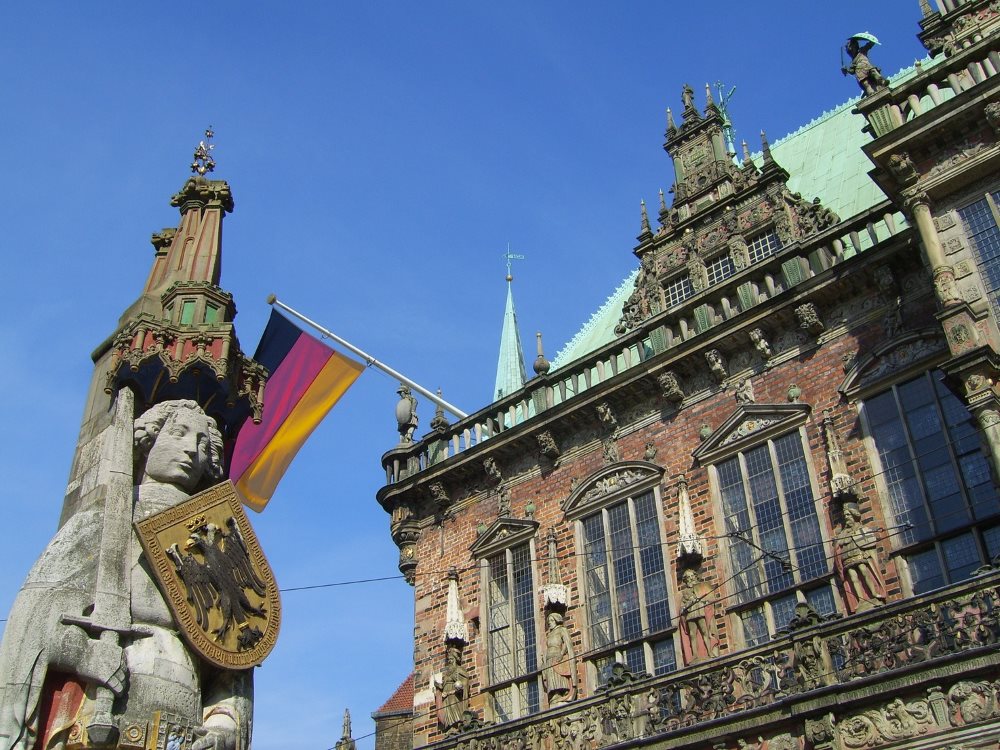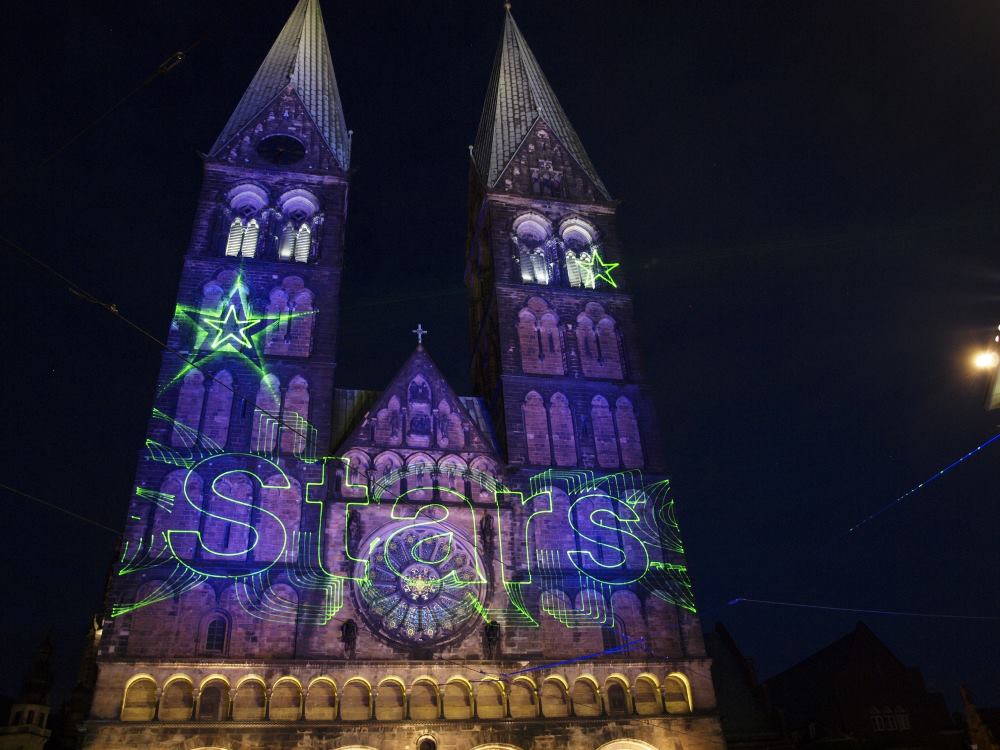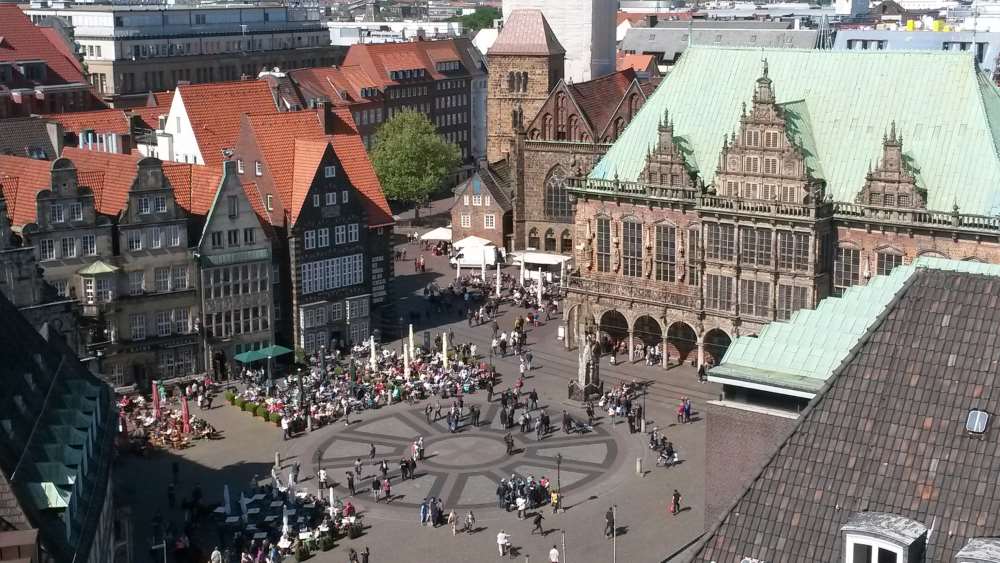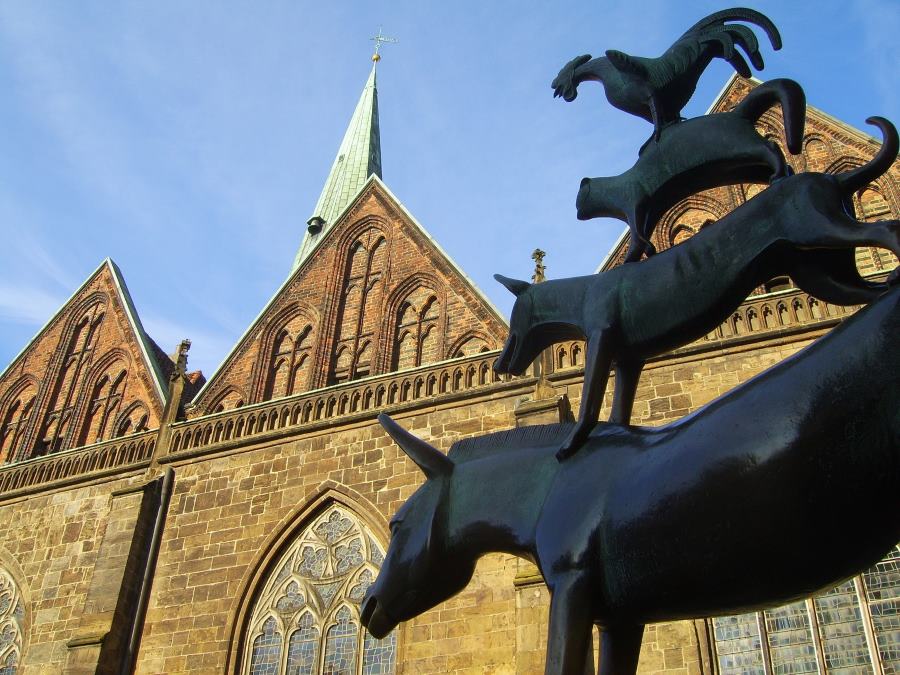Bremen, the Hanseatic city on the Weser river, can look back on 1,200 years of history. The grand old buildings around the market square betray its roots as a trading center, but Bremen has the feel of a city on the up. Besides its cosmopolitan appeal, Bremen offers a journey back through the centuries, full of monuments to a distinguished history and bristling with enthralling stories. There are pretty little houses lined up like pearls on a string, donkeys that shake hands and a cathedral under close observation.
Bremen’s attractions include the ornate Weser Renaissance town hall (UNESCO World Heritage), the Schnoor – Bremen’s oldest quarter, the quaint buildings in Böttcherstrasse, the cathedral and the statue of Roland on the historical market square. The Roland, Bremen’s very own ‘statue of liberty’, has stood as an emblem of independence since 1404. A tour of the most notable sights does not even require a map, as 2,000 brass and steel studs guide visitors from Liebfrauenkirchhof to Böttcherstrasse via the market square and the Schnoor quarter.

The route starts with one of the city’s most recognised landmarks. Between the town hall and the Church of Our Lady stands the bronze statue of the Bremen Town Musicians designed by Gerhard Marcks. The fairytale about these intrepid animals is known around the world. Since being popularised by the Brothers Grimm it is as closely associated with Bremen as the town hall and the Roland statue. It’s said to be lucky to touch the donkey’s legs, and anyone who does so is granted a wish. But it has to be done properly. The donkey’s legs must be rubbed lightly with both hands, otherwise the wish is just wishful thinking. As far as the locals are concerned, the incorrect version using only one hand is simply a case of two donkeys shaking hands.
Also on the western side of the town hall, just a stone’s throw from the Bremen Town Musicians, is the entrance to the oldest wine cellar in Germany – the Ratskeller, where people have enjoyed fine wine and good food since 1409. It is the largest repository of German wines, with 1,200 exquisite varieties. This large vaulted hall has welcomed plenty of famous characters among its columns and ornate wine barrels, including the poet Heinrich Heine, who was inspired to put it into verse, and Wilhelm Hauff who based his novella Phantasien im Bremer Ratskeller here.
The 600-year-old town hall is Bremen’s pride and joy. Its special status was confirmed in 2004 when it became a UNESCO World Heritage site, together with the Roland statue that stands on the market square outside. UNESCO’s justification for its inscription was gushing in its praise, describing Bremen Town Hall and the Roland statue as “an outstanding ensemble which bears an exceptional testimony to civic autonomy and sovereignty, as these developed in the Holy Roman Empire.” The report also expressly acknowledged the town hall as an “outstanding example of the Weser Renaissance architectural style in northern Germany”.
The building’s architectural splendour makes it the jewel in the crown of Bremen’s historical market square. The Upper Hall, where the city council used to convene, is the most magnificent ceremonial venue in Bremen. The model ships that hang from the ceiling bear witness to the importance of commerce and maritime trade. Their miniature cannons can even be fired if the occasion demands. In the early 20th century an extension was added to the town hall to create much-needed extra space. Designed by architect Gabriel von Seidel, the new building blends seamlessly with the medieval section to form a harmonious whole.
The Roland statue, which stands a few meters in front of the town hall, is no less impressive. Several of its wooden predecessors went up in flames, as this emblem of the power of the merchants’ guild and symbol of the freedom of the Hanseatic city was always a great annoyance to the church. The statue’s eyes are deliberately directed at the episcopal cathedral, to reinforce the claim of Bremen’s merchants to sovereignty of the city. Carved from stone, the statue has been standing on Bremen’s historical market square for more than 600 years, “the most representative and one of the oldest Roland statues erected as a symbol of market rights and freedom”, according to the UNESCO inscription.

To the east of the town hall, under the watchful eye of the Roland statue, stands St. Peter’s Cathedral. The spires of Bremen’s tallest building are 99 metres high. It is an unwritten rule that no structure in Bremen is allowed to be taller than the cathedral. Built primarily from sandstone, its architecture contains Romanesque and Gothic elements. The twin-towered facade is dominated by a rose window from the 13th century. The rococo pulpit dates from 1653 and was a present from Queen Christina of Sweden. Despite the preeminent position of Bremen’s guilds, St. Peter’s Cathedral retains some links with the secular powers in the Hanseatic city. According to the Gospel of St. Matthew, the cathedral’s patron saint holds the keys to the kingdom of heaven. Bremen’s secular rulers appropriated one of them for the city’s coat of arms back in medieval times. The coat of arms in its current form is based on a decree from 1891.
Just a few minute’s walk from the cathedral lies a chance to step back in time. Pretty little half-timbered houses dating back to the 15th and 16th centuries line the narrow lanes of Bremen’s oldest quarter, the Schnoor. One interpretation of the name is that this part of the old fishermen’s quarter was where the rope makers used to live, Schnoor being Low German for Schnur (string). The Schnoor quarter is right by the Weser river, and the lanes between the rows of buildings are often very narrow. Visitors can browse for arts and crafts and hand-made gold, rest their legs in one of the many cafés and restaurants or buy a souvenir to take home.

The past comes to life at the House of History, with stories that are as much part of Bremen as the town hall and the Roland statue. The friendly gentleman at the entrance with the scallop shells on his tricorn is Jacobus Major. His wooden likeness hangs above the door, but at the House of History visitors can also meet him in the flesh, as he tells them why the route of the famous pilgrimage to Santiago de Compostela went through Bremen. He may well introduce his guests to Heini Holtenbeen, who makes cigars as they watch and who in turn takes them to meet Fish Lucie. Anyone brave enough to make the acquaintance of the infamous poisoner Gesche Gottfried should get her to serve them a cup of unfiltered coffee, a Bremen tradition. They will need to grind it first though, in an old-fashioned manual coffee grinder. Then there is an old merchant vessel to navigate, a vintage grocer’s shop to admire and plenty more to see and learn about the history of Bremen and the Schnoor quarter.
Only a few metres down the river from the Schnoor quarter and along the Schlachte Embankment lies the site of a remarkable project combining art and architecture. The name Böttcherstrasse derives from the coopers (Böttcher) who used to live and work here. Today this narrow lane is home to arts and craft shops and studios. Local coffee merchant Ludwig Roselius began to buy up its dilapidated houses at the start of the 20th century and had them restored to form an architecturally notable and homogenous ensemble. With the help of architects Bernhard Hötger, Eduard Scotland and Alfred Runge, Roselius – the inventor of decaffeinated coffee – achieved his goal: to turn this pathway between the market square and the Weser river into a street of houses designed specially to be of architectural merit, in a mixture of art deco and brick-built styles. Roselius’ principal aim was a return to traditional Low German culture in language, art and crafts.
One of the highlights in Böttcherstrasse is the revolving tower in the wall between the Carillon House and Roselius House. To the sounds of the carillon it depicts famous ocean voyagers, a reference by Roselius to the pioneering spirit of Bremen. The first airplane that crossed the Atlantic from east to west was built in Bremen, a Junkers W33 called ‘Bremen’. Another type of pioneering spirit is represented by the Paula Modersohn-Becker House, also located on Böttcherstrasse, the first museum in the world to be dedicated to a woman. There are also many small studios where visitors can watch artisans as they work. The location of Böttcherstrasse, right between the Weser and the market square, makes the little lane particularly attractive for tourists.

Back on the market square, to the right, directly opposite the town hall is the seat of Bremen’s chamber of commerce, the Schütting. The front of the 16th century Renaissance-style building proudly displays the motto of Bremen’s merchants: buten un binnen, wagen un winnen. This Low German phrase sums up the strategy for success of Bremen’s guilds. Roughly translated, it means “outside and in, venture and win”. In the Second World War all but the outer walls of the building were lost in a fire. When it was rebuilt, the exterior was replicated in the same style, but the interior was redesigned. The Schütting was home to the first coffee house in the German-speaking world. Its serving license from 1673 also makes Bremen the first town in Germany where it was legal to serve coffee.
Just a few minutes’ walk from the Schütting are the old city scales, or Stadtwaage, where every trader had to have his goods weighed. The building was designed by Lüder von Bentheim between 1586 and 1588 and is a fine example of Weser Renaissance architecture. Like many other buildings in Bremen the city scales fell victim to bombing on 6 October 1944. Due to disagreements about the design, the reconstructed façade now contains a modern building which is home to the Günter Grass Foundation and the German Philharmonic Chamber Orchestra of Bremen.
BTZ: Experience Historic Bremen
History buffs can also find plenty of interesting destinations outside the city center. A visit to the Focke Museum is an excellent opportunity for anyone interested in the history of art and culture to immerse themselves in Bremen’s past. The museum has exhibits from the pre-history and early history of the Bremen region, and from the early Middle Ages. Maritime history is also covered. The exhibitions at the Focke Museum are constantly updated with themes exploring crafts and design, as well as photography and art.
Überseestadt, Bremen’s newest district, offers more architectural gems. The Speicher XI Harbour Museum exemplifies the transformation of an old warehouse. This former harbour building with its historical brick-build exterior now houses an innovative mixture of art, entertainment and office space. Bremen’s longest building contains the University of the Arts, the Überseestadt information centre, the Harbour Museum and companies in the creative industries. A fine example of living history in the Hanseatic city.
Bremen’s Überseestadt district provides a lesson in how to merge the past and the present. One of the largest regeneration projects in Europe, an innovative city quarter is being created here right on the banks of the Weser among the old docks. The new architecture rising up next to converted old structures gives Überseestadt its dynamic flair.
For further information on Bremen, please visit Bremen Tourism.
You may also like:
Destination Germany: Travel Resources
Train stations in Germany
Of peat barges, pirate ships and container terminals – Maritime Bremen
Stuttgart for Art Lovers: From Knights to Hawaii
Experiencing a creative urban lifestyle along the Danube
